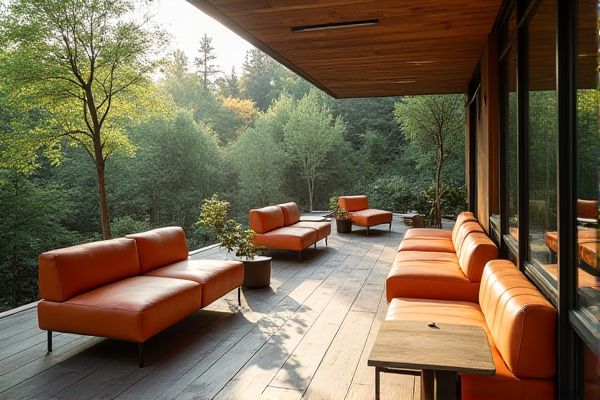
Modular seating offers flexible arrangements and easy reconfiguration, ideal for terraces needing adaptability, while fixed seating provides permanent, stable installations with a sleek, durable design. Discover which seating option suits Your terrace best by exploring the detailed comparison in the rest of this article.
Table of Comparison
| Feature | Modular Seating | Fixed Seating (Terrace) |
|---|---|---|
| Flexibility | Highly adaptable - easy to rearrange or expand | Permanent layout - no changes once installed |
| Installation | Quick and simple, often prefabricated | Complex, requires structural work |
| Cost | Initial investment is moderate; long-term savings with reusability | Higher upfront cost due to permanent structure |
| Maintenance | Easy to clean and replace parts | Maintenance can be costly and complex |
| Durability | Good for indoor/outdoor; depends on materials | Highly durable, designed for outdoor terraces |
| Comfort | Varies by design; customizable cushions available | Ergonomic designs common; fixed cushions or none |
| Space Efficiency | Configurable to available space, may be less dense | Optimized for maximum seating in fixed area |
Introduction: Modular vs Fixed Terrace Seating
Modular terrace seating offers flexibility with customizable configurations that can be easily restructured to suit different event sizes and layouts, enhancing user comfort and space utilization. Fixed terrace seating, by contrast, provides a permanent, sturdy solution with consistent arrangement but lacks adaptability for changing needs or dynamic crowd management. Venue managers prioritize modular seating for multifunctional spaces, while fixed seating remains preferred for stadiums and theaters requiring fixed sightlines and durability.
Design Flexibility and Adaptability
Modular seating offers superior design flexibility and adaptability by allowing sections to be reconfigured, expanded, or reduced to suit various event types and audience sizes, unlike fixed seating which remains static and limits spatial customization. Terrace seating with modular units can easily adapt to changes in venue layout or functional requirements, enhancing user experience and operational efficiency. This adaptability supports diverse uses, from concerts to sports events, ensuring optimal visibility and comfort in multiple configurations.
Space Utilization and Capacity
Modular seating offers flexible space utilization by allowing easy reconfiguration to accommodate varying group sizes, maximizing usable areas and increasing overall capacity. Fixed seating in terraces provides structured, permanent placements that optimize sightlines and stability but limits adaptability to different event requirements. Choosing modular seating enhances versatility in venue layout, enabling improved capacity management, whereas fixed seating ensures consistent, uniform arrangement with predetermined occupancy.
Installation and Assembly Process
Modular seating offers a flexible and efficient installation process with prefabricated components that can be quickly assembled on-site, reducing labor time and minimizing disruption. Fixed seating terraces require extensive groundwork and permanent anchoring, involving heavier construction efforts and longer installation periods. The adaptability of modular systems allows for easy customization and scalability, contrasting with the rigid structure of fixed seating terraces.
Maintenance and Longevity
Modular seating offers easier maintenance due to its detachable components, allowing you to replace or repair sections without disrupting the entire terrace setup. Fixed seating, while generally more durable, can require more extensive repairs and maintenance over time because damage often affects larger, integrated sections. Choosing modular designs enhances longevity by simplifying upkeep and minimizing downtime for your terrace area.
Comfort and User Experience
Modular seating offers customizable configurations that enhance comfort by allowing users to adjust seating arrangements according to individual preferences and group sizes, improving overall user experience. Fixed terrace seating provides consistent structure and durability but often lacks flexibility, which can lead to less personalized comfort and restricted accessibility. Ergonomic design in modular systems often incorporates better cushioning and adaptive spacing, directly contributing to prolonged user comfort compared to traditional fixed seating options.
Aesthetic Versatility
Modular seating offers superior aesthetic versatility by allowing you to customize and rearrange components to suit different spaces and design preferences. Fixed seating on terraces often limits visual variety, as its permanent structure restricts layout changes and personalization. This adaptability makes modular seating ideal for creating dynamic, stylish outdoor environments tailored to your unique aesthetic.
Cost Considerations and Budgeting
Modular seating offers flexible cost management by allowing phased purchases and easier upgrades, making it ideal for varying budgets and future expansions. Fixed seating in terraces requires a higher initial investment due to permanent installation and limited adaptability, often leading to increased long-term maintenance expenses. Evaluating your budget against project scope and expected usage helps determine the most cost-effective seating solution.
Applications: Ideal Venues and Use Cases
Modular seating systems offer unparalleled flexibility, making them ideal for venues such as conference centers, theaters, and multipurpose event spaces where reconfiguration is often required. Fixed seating terraces are best suited for permanent installations in stadiums, auditoriums, and lecture halls where consistent seating arrangements and durability are essential. The adaptability of modular seating supports diverse event types and audience sizes, while fixed seating provides stability and enhanced comfort for long-term use.
Sustainability and Environmental Impact
Modular seating offers greater sustainability compared to fixed seating terraces by enabling easy disassembly, reuse, and reconfiguration, significantly reducing material waste and environmental footprint. Fixed seating structures often require extensive demolition and disposal when renovated or replaced, leading to higher carbon emissions and resource consumption. Your choice of modular seating supports eco-friendly practices by promoting circular economy principles through durable materials and adaptable design.
 homyna.com
homyna.com